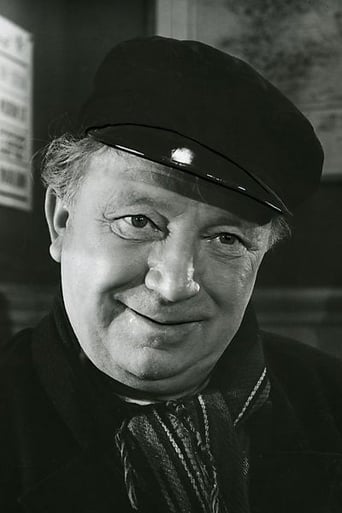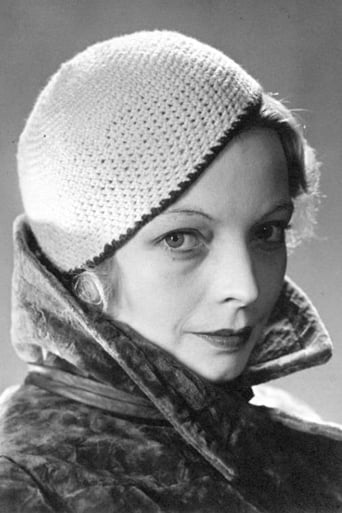Steineded
How sad is this?
Acensbart
Excellent but underrated film
Dynamixor
The performances transcend the film's tropes, grounding it in characters that feel more complete than this subgenre often produces.
Voxitype
Good films always raise compelling questions, whether the format is fiction or documentary fact.
Antonius Block
You'll have to forgive Laila for its slow pace, which is a common enough problem for films of this era. Director George Schnéevoigt tends to draw scenes out in what seem like unnecessary ways, including holding the camera on his actors' faces for too many seconds as they emote, and the film should have been shorter than its 2 hour and 45 minute run time. However, if you can cope with that, this film has a lot of visual treats that make it well worth watching, and is fairly unique besides.Filmed in the Finnmark region of the extreme northeast part of Norway, 'Laila' deals with the cultural differences between the Lapps, the nomadic indigenous people who were primarily reindeer herders, and the Norwegians, who were primarily settlers and traders. At the center of the story is Laila (Mona Mårtenson), a young woman who was born Norwegian, but through a couple of tragic accidents, ends up being raised by Lapps. As she grows up, she's promised to her Lapp step-brother (Henry Gleditsch), but finds herself falling for a Norwegian (Harald Schwenzen) who turns out to be her cousin. Mårtenson is athletic and beautiful, and the two men in this love triangle are both rather dashing, which adds to the natural scenic beauty of their surroundings.While the story itself gets a little melodramatic at times, the best part of the film is how it transports us to this remote part of the world. We see packs of wolves bounding through deep snow, and large herds of majestic reindeer. We see reindeer being tamed, and pulling individual sleds and people on skis. The traditional apparel is fantastic – the hats, big furs, and the way babies were thoroughly wrapped up. The visual appearance of the older Lapp men (played by Tryggve Larssen and Peter Malberg) is striking, with their strong eyebrows and features. In one scene, a Lapp mother gives her two boys a hot bath, then turns them out naked to roll around in the snow. In others, Mårtenson gracefully pilots a canoe. With all of that and the beautiful snowy scenery, it's just a delight to watch.
FerdinandVonGalitzien
The Danish silent film director Herr George Schnéevoigt had previous to his excellent oeuvre "Laila" (1929) a reputable career as a cinematographer, working in many early Herr Carl Theodor Dreyer silent films as well as in Herr Gunnar Sommerfeldt's "Markens Grode" (1921), another excellent Norwegian silent oeuvre. The latter is certainly very important in order to understand the magnificent and exquisite treatment of wild nature and the smooth dramatic intensity in "Laila".Filmed in varied and beautiful Norwegian places ( interiors were shot at Nordisk Film Company's Studio ) Herr Schnéevoigt drew on his experience as a cinematographer to reflect the cinematic and dramatic potential of Norwegian landscapes for his adaptation of the eponymous novel by Herr J. A. Friis. Laila is a young fraulein who, when her parents take her to be baptized in a distant town from home, is lost after her family is chased by wolves. Herr Jampa, a Lapp and servant of a wealthy reindeer owner Herr Lagje, finds the baby and thus she is raised as a Lapp.The tundra is the constant background in "Laila" determining the dramatic elements of the story as well the daily lives of the characters, combining thrilling sequences like the attack of the hungry wolves and the danger of deadly waterfalls. The Lapps live in a cold and hard environment but even there love thrives even though difficulties transpire when prejudice comes to the surface ( The Lapps are a racial and social minority within Norway ).In spite of the realism of the setting and the accurate depiction of the idiosyncrasies of the locals Herr Schnéevoigt is not constructing a documentary. "Laila" is fiction and tells a universal story, a "common" one about true feelings and love against a harsh background and a brilliant depiction of ancient cultures in the tundra. Herr Schnéevoigt brilliantly combines nature, ethnography and social prejudices to make a film with terrific cinematic power wherein adventure, romance and melodrama are given equal weight. The actors are inspired and perfectly suited to their roles as Lapps or Norwegians, two different and divergent cultures. At this point it is necessary to say this beautiful restored silent film was recently released in modernen disc format by the longhaired youngsters at "Flicker Alley" in collaboration with some Norwegian foundations. The disc includes a brand new piano score by Herr Robert Israel. Flicker Alley has made it possible for silent film fans around the world to enjoy what is one of the best Norwegian silent films ever made.And now, if you'll allow me, I must temporarily take my leave because this German Count must defrost himself.
oOgiandujaOo_and_Eddy_Merckx
This is one of the first chances anyone has had to see this film in a proper condition in living memory. It played at the renowned Pordenone silent film festival last year and happily made it to London this. It was restored in the seventies for Norwegian TV, but it was played at the wrong frame rate, so folks were seeing a 165 minute movie in 120 minutes (and with subtitles instead of intertitles!), which was obviously a mockery.The film is about a baby called Laila who we see grow into a little girl and finally a young woman during the film. She lives an exciting nomadic life with the whole tundra her playground. She is played by Mona Mårtenson, who is a wonder to behold. The movie is a drama of faces, there is a number of hugely expressive faces in the film, and all you can do is sit there and take in their radiance and pure joie de vivre. Mona for example really is a damned livewire, it's all she can do to stop bursting out of her skin, happiness is written all over her face. With silent film it really does help if you have expressive actors, and they hit the jackpot of them with this movie.There's a lot of racial subtext in this movie which is mined as a source of amusement more than anything else (the film occasionally sails provocatively close to the wind in terms of racism). Apart from Laila's scrapes with death the film is a love story where Laila has to choose between a Finn and a Norwegian. Laila is a woman caught between two cultures, she is ethnically Norwegian but gets brought up with Sami (called Lapps in this film) who are the indigenous people of Finnmark. I think folks watching the film mistook Finnmark to be a concoction of Finland and Denmark, used to introduce a location nonspecifically (judging from the tittering). However it is the province at the very top of Norway, the Far North Eastern tip. Here the Sami people traditionally live off reindeer herding, and in fact you now have to be Sami in order to profit from reindeer husbandry in Norway by law. So they are a nomadic people, as opposed to the Norwegian's who lived off farming and trade via the fjords.Sami are generally distinguished in this movie in that they wear a traditional ciehgahpir (which is a Four Winds Hat, a pretty particoloured chapeau, not too dissimilar to a jester's hat). They are a damned lively bunch, whose favourite pastime, hilariously, is lassoing. It was guaranteed to get a laugh from the audience every time Laila decided to lasso something.The two main Sami men in the movie are the loyal Jåmpa and the rich man Aslag Laagje. Seeing those two I was strongly reminded of Frans Hals portraiture and Dreyer's film Der van engang (1922). A couple of lusty fellows with epic eyebrows who lead a nomadic life of wolf hunting and reindeer herding. The light of their life is Laila, their happiness continually bound to her fortunes.The flavour of this epic movie is the joie de vivre previously alluded to. There's a positive joy associated with the presence of children and with mere existence that simply is no longer possible to capture at this point in time. It's a cynical world we have now where folks have to worry about events and processes that are far beyond their control, and it's no longer clear why we bring children into the world.For nearly three hours though the audience forgot about that and revelled in the entertainment. It's a measure of the sheer good-naturedness of the film that when the melodrama comes along towards the end of the film, even though it's almost absurd, you're carried along willingly.I only wish I could have watched it with my dog so she could have barked at the wolves. Yes there really is something for everyone here.
larswerme
Not laden with the obvious and overstated national romanticism in the pictorial compositions as a few of its Norwegian contemporaries (most notably Rasmus Breistein's "Brudeferden i Hardanger", 1926), this film displays a certain freshness unusual for Norwegian films to date. Part of this fact is probably due to having a Dane direct in the relatively harsh conditions of northern Norway (mostly) during winter. Another factor is the very lively Mona Mårtensson as Laila, although she appears in the second half of the film, which is inferior to the first due to its rather melodramatic turn. Slipping at times into theatrical overacting, Mårtensson still mostly conveys the liberating, semi-naive and cut to the chase-attitude of Laila on the verge of adulthood torn between two cultures and mind sets: If one is to over-determine, the best of her performance is very liberating in the way it shows Laila as an improvising individual in her encounters with the Norwegians at the trading post, putting up the face of nomadic same culture penetrating and breaking the ice of the western European respectively. The editing of the film also serves up some (for is time, ontologically) very good disposing of the story, as we the viewers in some vital situations are held in suspense through a sort of reverse dramatical irony, not being told things in the right chronological order. The nature of this is not filmically complex, but it has a peculiar (unintended?) effect of enhancing the broader existential feel of the plot. As when the baby Laila's crib is first found empty, suggesting to us and the mother that she has been taken by the wolves, BEFORE we are told in a flashback who has really found her, which is of course STILL OBSCURE to the mother.As a final note, this film was recently screened at the Cinematheque in Oslo at its right speed of 16 fps., making it both comfortably realistic and a good 2 hours and 40 minutes long, which is certainly felt towards the end, when melodrama peaks. Note how the character Mellet disappears out of the film, slightly out of focus in the back of the picture, walking out of the frame behind the kissing couple. Very sad, and at the same time sort of reminiscent of the implications of Welles' much acclaimed depth-of-field revolution 12 years later...



